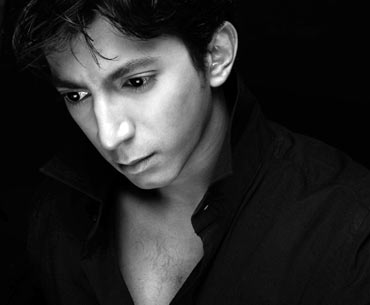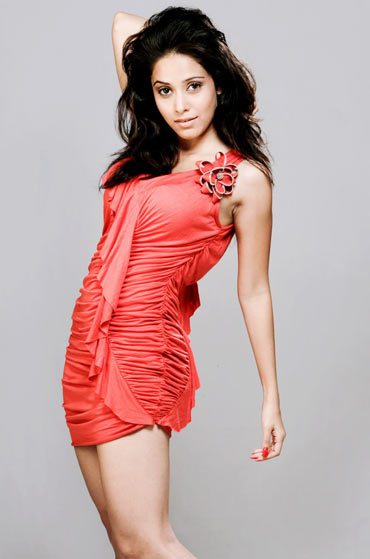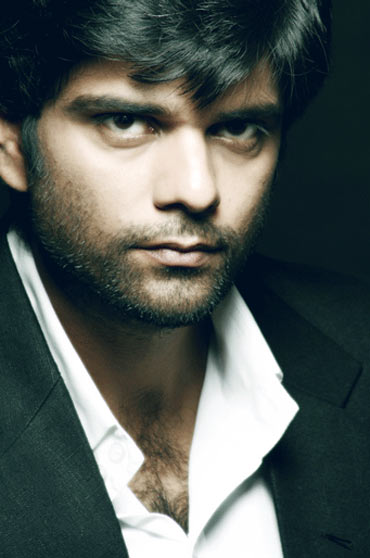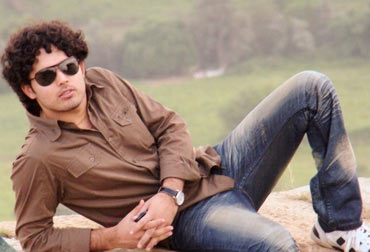 | « Back to article | Print this article |
Meet the newcomers who rock LSD!
Anshuman Jha, 25, is a terribly busy man. He's been giving radio interviews, speaking to the press, touring cities and enjoying all the attention.
Many of you may know him as Rahul, the young and affable film student in Dibakar Banerjee's Love Sex aur Dhokha, who dreams of being the next candy floss romance director like Aditya Chopra.
He's the man who -- in the process of making his first film -- falls in love with the heroine, marries her and eventually gets brutally murdered along with his new bride in an honour killing. His on-screen bride, Shruti, in fact, is nursing a sore throat when we start our interview with her.
"Sorry, I've been really caught up," she says, quickly launching into a witty monologue about the film and her career plans as an actor.
'I'm ugly and I know it damn well'
There's also Arya Banerjee, a Kolkata-based model who can't believe that a low budget "experimental" film has given her the sort of attention that she had only dreamt of.
Who are these new-actors-on-the-block? Most of them can't even boast of sexy figures, brawny muscles or conventional good looks, but they still have the likes of Madhur Bhandarkar, Aamir Khan, Karan Johar and other Bollywood luminaries walking up to them and congratulating them on their 'good work'.
Jha laughs out loud, "Oh, yes. I'm ugly and I know it damn well. But I'm good at my craft and I know that too." LSD, he says, offered him a chance to perform. "Hell, LSD got me to convince everyone that I was the most good-looking guy around to attract the attention of his film's heroine," Jha chuckles.
"I've been chief assistant director on films with veteran directors but seriously, the making of LSD has been way different. In fact, more than dialogue delivery, we concentrated on learning camera movements."
Jha has a point. LSD, touted on its official website as India's 'premier digital film', has gone ahead and broken most of the conventional rules in filmmaking.
Divided into three segments, LSD -- busy getting labelled as avant-garde -- was made at a cost of Rs 2.5 crore and starred a bunch of newcomers.
Shot on digital cameras, spycams and other types of cameras, the film's first week's collection stood at Rs 6.5 crore.
What's more, apart from doing well in the metros, it's been a hit in smaller cities like Varanasi, Solapur, Nasik, Gorakhpur, Latur and Meerut, to name a few.
'We were struggling actors, genuinely waiting for a good break'
Not surprisingly, the film's actors are busy getting felicitated in different cities; from ribbon cutting to attending press conferences to promoting the film in different cities, they're getting used to being in the limelight.
What makes their success so special is the fact that none of them are known faces or sons/daughters of stars, none of them, in fact, are known faces. The only common thread is their individual struggle to make a mark in the industry.
"We were struggling actors, genuinely waiting for a good break," reasons Shruti, who has always been rejected roles because she's not tall. She laughs, "The minute I was asked any questions pertaining to my height, I knew I'd lose out."
Naturally, she was surprised when the casting director of LSD, Atul Mongia (also the brother of the character Shruti in the film), didn't ask her any such questions.
From Mumbai's Juhu area, Shruti did summer jobs to sustain herself before seriously trying out acting. Did Shruti anticipate the 'cult' status that it's acquiring now? "It gives me goose bumps, seriously," she says, softly.
'Despite LSD's success, my struggles continue'
All these actors had been waiting in the wings for that one debut break. "I had taken to calling Dibakar incessantly," says Amit Sial, the actor who essays the role of news cameraperson Prabhat in the movie's third segment.
Sial's "fault", as he impishly calls it, was "being one film old". He adds, "Dibakar was clear that he wanted all newcomers and since I'd already worked on Hope and a Little Sugar (Tanuja Chandra's film), he was very reluctant to give me a chance. Luckily, I convinced him."
Sial, originally from Kanpur, has been travelling to different cities to gauge the responses of the audiences. "I'm overwhelmed," he gasps.
He has been actively involved in theatre since 1994 and though he went to Australia for further studies and came back to do business, he chucked it to pursue his dream of acting.
He came to Mumbai and despite several setbacks, he continued auditioning for roles. "LSD's success has made a difference," he smiles, quickly adding, "My struggles, however, continue."
'Our struggles have only begun'
Banerjee, for her part, was apprehensive about her debut film. "Before LSD released, Dibakar had told us not to have any grand expectation from it. I frankly had doubts about how audiences would receive the film," she smiles.
Unlike her, Herry Tangri (the colourful popstar Loki Local) was sure that it would be a "cult classic". "Anyone who wanted intelligent cinema was sure to love the film," he says.
The Ludhiana-based lad says that surprisingly many of his neighbourhood "auntijis" back home loved his role in the film.
Tangri, if you speak to him, is aware of his "good looks" and confesses that "I wanted to be in films."
Having finished a diploma course in media and filmmaking in Jalandhar, he strutted into Mumbai studios and clinched work as an assistant director in a couple of films. He says, rather unabashedly, "When Atul [Mongia] saw me, he said, 'Herry, you are too good-looking for the role, but let's try.'"
The "trial" secured him a role and Tangri says that he's enjoying the attention -- Facebook messages, photo-shoots, radio, and press interviews.
How have the lives of these youngsters changed, post LSD?
"Our struggles have only begun. Films like LSD aren't made often and I don't know how many filmmakers will give us challenging roles," confesses Shruti.
Raj Kumar Yadav, who played the complex role of Adarsh, says, "I've gone from door to door with my show reel in the hope that I'll get good roles. With LSD, which I've watched about nine times, I do hope things will get better."





